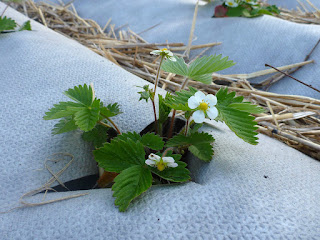A Month of Strawberries
May is National Strawberry Month, the time when British strawberries grown outside come into season. Of course, with planning, you can grow and eat them over a much longer period, but the first taste of fresh strawberries in May or June is a real treat.
Grow different varieties according to your needs. There is a wide choice of early, mid-season, and late cropping plants. Everbearing strawberries will produce fruit over a long season but won't provide enough for jam-making. Try some types you can't buy in the supermarket - they will be tastier.
Most of us tend to grow our strawberries on level ground and accept some losses from slugs and birds. A few of the more diligent plot-holders amongst us make the effort to safeguard their crops - like the ones shown in the photo above on plot 14B last year.
Ideally, the soil should be ridged before planting your strawberries. This helps to keep the over-hanging fruit clear of the soil (and the slugs). Using an anti-weed membrane or packing straw around the plants also keeps the fruit clean by avoiding muddy splash-backs in a downpour.
Protect early blossom from late frosts by covering with a fleece. Replace this with netting to keep the birds off. A removable cage is handy as you will need access to the fruit for picking every few days.
If you have created a new strawberry bed, don't allow the plants make runners for the first couple of years as this will divert too much of the plant's energy away from producing fruit. You need to be diligent in cutting off the new growth every week. Cut the whole plant back to the crown when fruiting has finished for the year.
A strawberry plant will fruit for around 4 years. In the third year allow the runners to grow and create new plants. These will form the basis of your next patch. Put a plant pot of soil under each baby strawberry plant then, once they have rooted, cut the runner. This makes it easier to transplant them into the new area.
Most of all, enjoy!
Grow different varieties according to your needs. There is a wide choice of early, mid-season, and late cropping plants. Everbearing strawberries will produce fruit over a long season but won't provide enough for jam-making. Try some types you can't buy in the supermarket - they will be tastier.
Most of us tend to grow our strawberries on level ground and accept some losses from slugs and birds. A few of the more diligent plot-holders amongst us make the effort to safeguard their crops - like the ones shown in the photo above on plot 14B last year.
Ideally, the soil should be ridged before planting your strawberries. This helps to keep the over-hanging fruit clear of the soil (and the slugs). Using an anti-weed membrane or packing straw around the plants also keeps the fruit clean by avoiding muddy splash-backs in a downpour.
Protect early blossom from late frosts by covering with a fleece. Replace this with netting to keep the birds off. A removable cage is handy as you will need access to the fruit for picking every few days.
If you have created a new strawberry bed, don't allow the plants make runners for the first couple of years as this will divert too much of the plant's energy away from producing fruit. You need to be diligent in cutting off the new growth every week. Cut the whole plant back to the crown when fruiting has finished for the year.
A strawberry plant will fruit for around 4 years. In the third year allow the runners to grow and create new plants. These will form the basis of your next patch. Put a plant pot of soil under each baby strawberry plant then, once they have rooted, cut the runner. This makes it easier to transplant them into the new area.
Most of all, enjoy!

Comments
Post a Comment